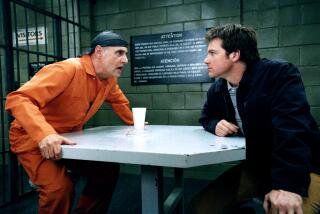‘Bronson’ shows inner chaos of a violent prisoner
A brawny, bald-headed figure in a vintage suit with a harlequin’s white makeup takes to an old-fashioned stage, narrating his own life with a born showman’s panache and relentless enthusiasm. Not a typical image for a prison picture, to be sure, but then “Bronson” -- about the man considered by many to be Britain’s most violent convict -- is no typical prison movie.
The real Michael Peterson was first incarcerated in 1974 at age 19 for a bungled armed robbery. His original sentence of seven years grew as he became involved in a series of violent acts against guards and fellow inmates while in custody. He has now spent 34 years in prison, 30 of those years in solitary confinement. Released briefly in 1988 and then in 1992, both times he landed back in custody within a few months. During his incarceration he created an alter ego for himself named for the film star Charles Bronson.
The film’s version of Peterson’s life is told in a powerfully expressive style that plays as a projection of the prisoner’s interior world, a dazzling blend that veers from kitchen-sink realism to boldly artificial mindscapes. Actor Tom Hardy, in a performance equal parts funny and ferocious, perfectly captures the film’s prismatic approach to its subject.
In turning Peterson’s life into a phantasmagorical character study seemingly drawn from the works of Stanley Kubrick and Hieronymus Bosch, director Nicolas Winding Refn has transformed the disturbed prisoner into a complex antihero. Tracing Peterson’s evolution into the self-made Bronson, the film seems to view his life as a piece of performance art, lived as willful, purposeful, chaos.
“I didn’t want to make a biopic of Michael Peterson, or a film about Charlie Bronson, I wanted to make a film about the transformation from Michael Peterson to Charlie Bronson,” Refn said.
Born in Copenhagen, Refn spent part of his childhood living in New York City before returning to Denmark. (His father is Anders Refn, a veteran film editor who recently worked on Lars von Trier’s “Antichrist.”) Refn’s first films, “Pusher” (1996) and “Bleeder” (1999), took an anti-romanticized view of life on the margins of Danish society, and could be thought of as European analogues to the early ‘90s crime films being made on the American independent scene (think “Reservoir Dogs” and “Bad Lieutenant”) for their take on low-life and underworld crime.
Refn went bankrupt when the financing collapsed while he was making his third feature, “Fear X” (2003), a period in his life startlingly portrayed in the documentary film “Gambler,” which follows Refn as his personal and professional worlds start to crumble. Refn made two “Pusher” sequels to get out of debt, and sees “Bronson” as, in his words, a “resurrection.”
“I was basically at rock bottom,” Refn, 39, said of that earlier period in his life.
The “Bronson” project had been gestating through a string of writers when producer Rupert Preston, who had distributed Refn’s previous films in the U.K., approached him. At first the existing screenplay struck Refn as just another British “lad’s picture,” exactly the kind of men-and-violence film he was trying to get away from. After reading Peterson’s autobiography, however, Refn saw the character differently, coming to the realization it was actually the story of a prisoner who wanted to stay in prison, not get out.
Hardy, who has had small roles in films such as “Black Hawk Down” and “RocknRolla,” was already attached, but Refn wasn’t sure if he was right for the part. After meeting with other actors, Refn finally came around to Hardy, realizing the actor’s growing relationship with the actual Michael Peterson-Charles Bronson made him the only choice.
“There simply is no film to speak of without him,” said Hardy in an e-mail of his relationship with Peterson, who is still living a life behind bars. “Without him as my inspiration there is no debate, no drama, nothing. It would be an empty film.”
Though Refn never met the notorious prisoner face-to-face, he did speak to him once on the phone for about 20 minutes, and Peterson nevertheless had a direct influence on the film itself.
“I wanted him to come up with some ideas for the monologue,” Refn said. “He actually sent me a letter with a few ideas I put into the movie, especially when he says, ‘Prison was madness at its very best.’ ”
It perhaps speaks to the brutal intensity and unlikely charisma of Hardy’s performance -- a singular, buzz-making turn if ever there was one -- that a recent Los Angeles public preview of “Bronson” brought out his costars in the upcoming Christopher Nolan film “Inception,” including Cillian Murphy and Leonardo DiCaprio.
At the recently concluded Toronto International Film Festival, Refn premiered a new film, “Valhalla Rising,” starring his frequent collaborator Mads Mikkelsen as a Viking warrior making his way to the New World.
The film is shot as an extension of the expressively disorienting style Refn landed upon making “Bronson.”
“I actually really like the way I did ‘Bronson,’ technically,” said Refn, “and I wanted to kind of pursue that more in ‘Valhalla.’
“ ‘Bronson’ is very much a catharsis for me. So now I’m like, ‘Phase 2 [of my life] can begin.’ ”
--
More to Read
Only good movies
Get the Indie Focus newsletter, Mark Olsen's weekly guide to the world of cinema.
You may occasionally receive promotional content from the Los Angeles Times.











